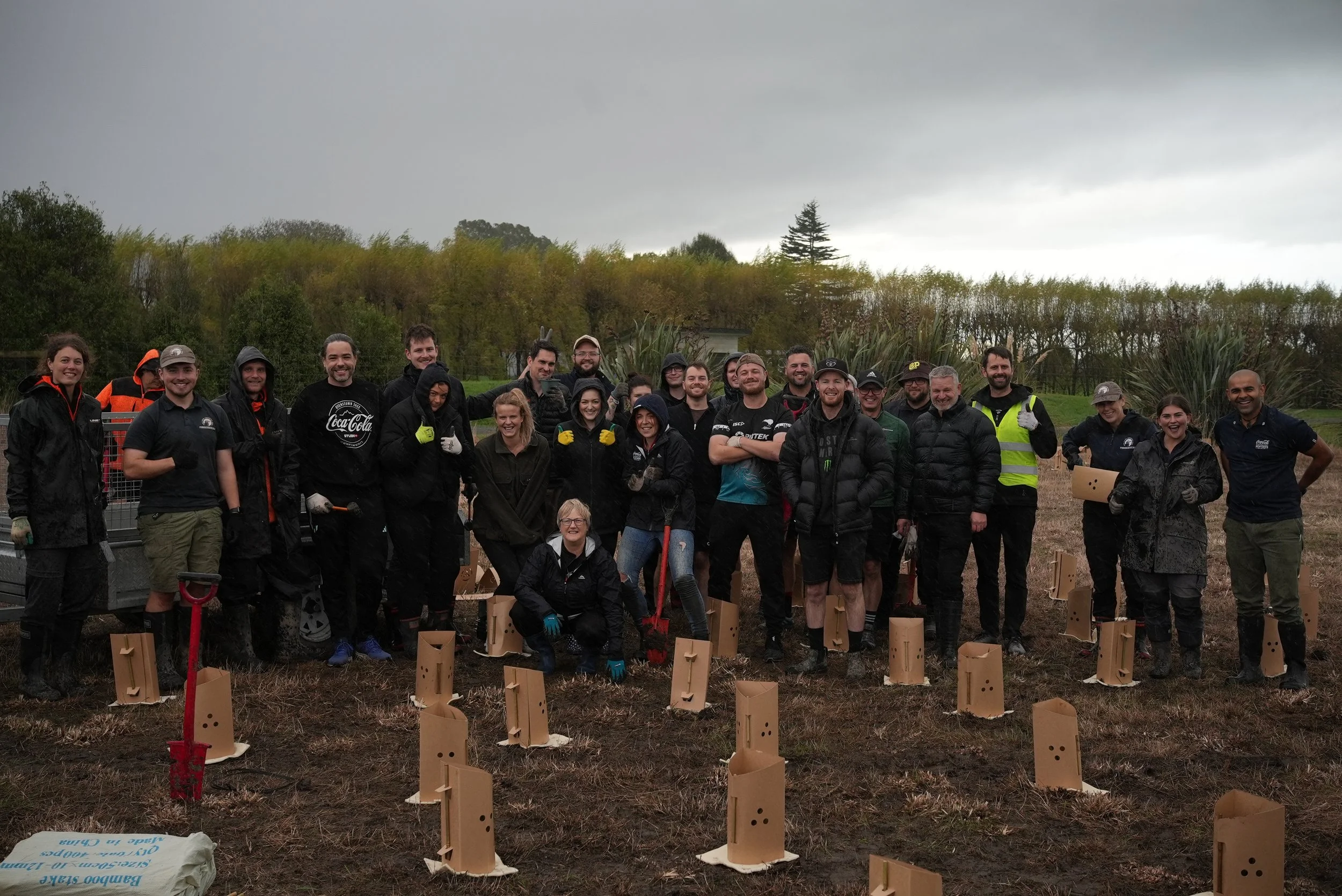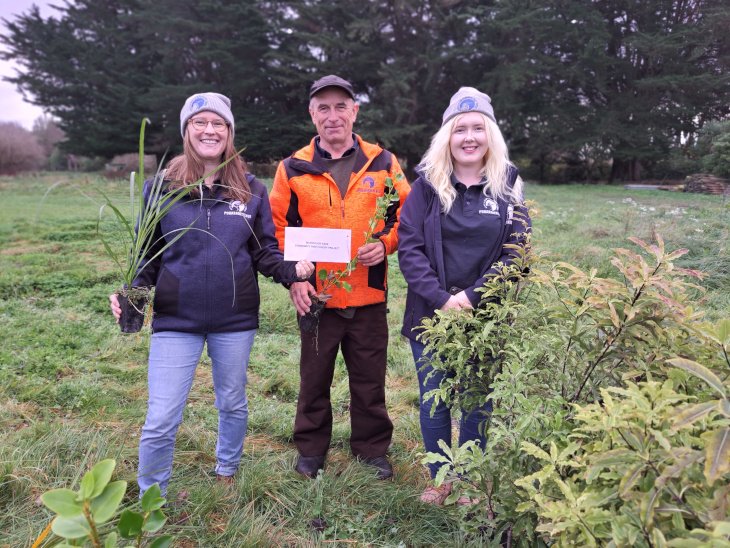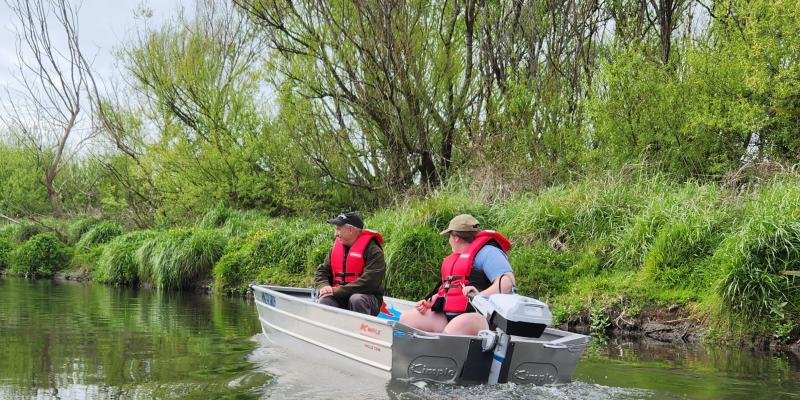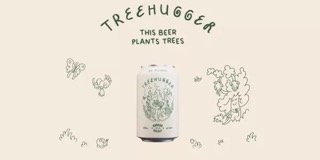Our Projects
We have a lot going on in the Styx! Have a browse below and if you want any further info - just get in touch.
To find the physical locations of the virtual reserves, click on the red dots in the interactive map below or by selecting the virtual reserve you want to learn more about below!
Augmented Reality Project
We're partnering with Lincoln University to develop augmented reality experiences in the Pūharakekenui. H5P technology has been used to give visitors to the Styx the opportunity to 'see' healthy and unhealthy underwater environments from the perspective of native freshwater species. You'll be able to see and hear the impact of pollution and sediment from the perspective of tuna (eels), waterbirds and invertebrates.
Project leader: Associate Professor Gillian Lawson, School of Landscape Architecture, Lincoln University: Gillian.Lawson@lincoln.ac.nz or 03 423 0461
Thanks to the Waitaha Action to Impact Fund, we've been able to undertake this project. Thanks to Jeremy (Jiang) Goh, our Landscape Architecture Masters student for the virtual environments and H5P work, Jo Burzynska, our Sound Artist for the audio recordings and sound advice and Wang (Flynn) Fei, our Applied Computing student, for web preparation and application with Blue Fusion, the web designers. Video recordings and captions were created and edited by Gill Lawson. Thanks to Dan Grima and John Harding for video recordings and site visits. Special thanks to Maire Kipa for her voice over of the project introduction and Aperahama Kipa, for his expertise in this project. The support and assistance from the Kahukura Rongoā Māori Healing Trust was greatly appreciated.
For further information contact styxllbom@gmail.com
Tell Us What You Think … by clicking here
This project aims to test the useability of AR experiences depicting plant and animal habitats prone to disturbance in the Pūharakekenui (Styx) River. These experiences may have the potential to change our attitudes to protecting these habitats and foster greater understanding of our environment from the perspectives of non-human organisms that depend on the river for their survival. If you are over 18, we are asking you to tell us what you think in this 10 min online survey (16 questions).
Data being collected will not be identifiable to you and it will be aggregated for possible use in future publications in academic journals and/or conferences. This means that no information will be reported in a way that might identify any individual participant. Your identity and data will remain private and confidential. If you have any queries or concerns about your participation in the project, please do not hesitate to contact the project leader. She will be happy to discuss any concerns you have about participating in the project.
Coca Cola Euro Pacific Project(s)
In 2021 the Project Kōtare team began working on a section of land owned by Coca Cola Euro Pacific (CCEP) along the Ka Pūtahi and have since received generous funding from CCEP to aid the Trust in achieving its restoration and monitoring goals in the Pūharakekenui/Styx.
In 2024, CCEP NZ provided $100,000 funding to support a range of environmental initiatives led by the Trust including:
Forest restoration - over 10,500 native plants planted in 2024 and 2025 by the SLLT, community volunteers, and CCEP Christchurch staff. Bringing the site total to over 24,000 plants.
The installation of protective fencing around restoration areas.
Enhanced water quality monitoring through the purchase and installation of a continuous turbidity monitor.
Early-stage support for the potential reintroduction of culturally significant native species.
Funding for new Hero video for the Trust (see below) in addition to sponsorship at the 2025 Coca Cola Christmas in the Park event.
Building on this momentum, CCEP NZ has pledged additional support for further enrichment of the site in 2025 and 2026 and is working alongside SLLT to help identify and connect with other commercial partners in the catchment, enabling the Trust to expand the incredible work they are doing to restore and protect this vital waterway.
Thanks to the Trust's partnership with CCEP we've been able to restore a significant area of land along the Ka Pūtahi Creek and continue to improve the health of Pūharakekenui/Styx catchment. Their support has also enabled us to further our commitment to undertake important research and monitoring work in the catchment as well as educate all members of the community on the importance of being kaitiaki/guardians of the natural environment. We're excited to keep our partnership moving forward with CCEP and see where the awa takes us next!
eDNA Project
Environmental DNA (eDNA) refers to all the small traces of genetic material that are left behind as living things pass through the soil or water. We have taken six samples across the Catchment and now have a list of all of the eDNA of the species found in the Catchment.
This can help with invasive species detection, ecosystem health evaluation and we have even found the eDNA of some species that we did not know were in the Styx including the New Zealand Long-Tailed Bat and the Freshwater Jellyfish.
The NZ Long-Tailed Bat is a threatened ‘nationally critical’ species which is the closest conservation status to extinction. The last reported sightings of this bat in Christchurch were almost 150 years ago. We have started undertaking bat detection surveys and if you have seen any bats in your backyard then we would love to hear from you.
Read more about this discovery here: https://www.stuff.co.nz/environment/129599610/native-bat-dna-unexpectedly-found-in-christchurch
Herbicide Tolerance Study
The most common reason native plantings fail is competition from weeds. Herbicides, when used responsibly, are one of the best ways to keep these weeds at bay. But there is very little information on how susceptible most native plants are to commonly used herbicides, meaning that when we use them in the field we need to either be too careful or take unwelcome risks.
With support from the Brian Mason Trust, we were able to test the herbicide tolerances of five understudied species common in our restoration plantings to herbicides used in the field, in an experiment that involved 700 plants.
We identified greater than expected vulnerability to the broadleaf weed control herbicides clopyralid and triclopyr, new opportunities to make better use of these chemicals, and confirmed that drift from a powerful herbicide during careful use around native plants causes no unintentional harm in most species. We've also collated information from this study and many other New Zealand studies to form a guide for field workers on known herbicide vulnerabilities and tolerances in native plants.
Read our report from this study here
Download our guide for field workers here
Janet Stewart Reserve Harakeke Restoration
Our Field Staff are working to restore Te Kōrari Pā Harakeke at Janet Stewart Reserve, with Christchurch City Council and advice from Paula Rigby, Te Rōpū Raranga Whatu o Aotearoa National Weavers Collective. This mahi involves the selective removal of plants to create more space and access, and maintenance of the remaining plants. The goal of this project is to restore the health of the harakeke so that this taonga resource is suitable for harvest again.
Te Kōrari is a pā harakeke planting established specifically for weaving purposes, with several varieties of harakeke suitable for different uses.
Kā Pūtahi Art and Connection
The Kā Pūtahi Art and Connection Project was funded by the Creative Communities Scheme and aimed to create a piece of artwork in the Kā Pūtahi near the Rongoā site that provided mana whenua a good place to sit and talk to their ancestors and connect with the land. This project began in 2021 when Kiwi Outdoor Risilence and Education (KORE) ran a weaving session with Belfast school. Approximately, 30 students kayaked down the awa and then harvested the harakeke(flax) to make the baskets for the seats.
The students spent an afternoon creating the baskets and then the Christchurch City Council Park Rangers filled these basket molds with concrete. One of the Park Rangers (Dave) created the seat bench whilst Ra from Mokopuna Māori Arts Gallery & Tāmoko carved the top part of the seat. The Kahukura Rongoā Māori Trust who are kaitiaki for the Rongoā site have supported the project also and decided on an appropriate location for the seat.
The seat was officially installed during the Matariki Celebrations in 2022 at the Rongoā Māori Demonstration Site.
Lower Styx River Restoration
This project is our first project in the Lower Styx. The project focuses on removing exotic weeds, controlling willow and underplanting with native eco-sourced plants along the riparian margins in Earlham Street. The Lower Styx River Restoration Project is funded by the Environment Canterbury Immediate Steps Fund.
As a result of this project by 2025, we want to see:
Native vegetation dominance across planted areas
Increased bird, fish, invertebrate and lizard species counts/abundance
Increased condition, extent, density and diversity of native vegetation within the site
Reduced and/or eliminated presence of targeted weed species
Improved condition, extent and density of mahinga kai species at the project site
Mapping Project
We have recruited two postgraduate students from Lincoln University to create a dynamic and engaging map that displays data such as bus routes, walking tracks, park locations, planting sites and much more! This is a joint project between SLLT and Lincoln University.
This project is split into two parts. Part A focuses on finding key baseline data and Part B focuses on creating spatial data.
Project Objectives are:
To encourage learning, research, collaboration and interaction;
Demonstrate environmental, social and cultural sustainability;
Integrate cultural and historic values and principles;
Increase accessibility of spatial data and enhance public awareness of the Pūharakekenui Catchment.
This project is due to be completed at the end of October 2022.
Check back in shortly to see our new user-friendly map.
This work has been funded by the Discretionary Response Fund.
Free Tree Project (2023 & 2024)
Free Tree Canopy Project
Did you know that there is less than 14% tree canopy cover in Ōtautahi?
We're trying to increase tree canopy coverage in Ōtautahi by donating 1000 trees to households in the Murchison Park area in 2023 and Englefield Reserve in 2024. We're partnering with Trees for Canterbury, Christchurch City Council and the University of Canterbury School of Forestry to better understand community forest restoration.
How does it work?
The Styx Living Laboratory Trust did a surprise delivery of 1040 trees to the Park Areas. Each tree will came with a brochure, weed mat and a gift certificate for an additional free tree thanks to our project partner Trees for Canterbury.
That's 2000 free trees for the each neighbourhood!
If everyone plants their trees in the area then it could increase tree canopy coverage in the neighbourhood from 11.87 % to almost 16% long term. This will help sequester carbon, create forest patches and support local bush birds.
Pūharakekenui Freshwater Improvement Fund
The Pūharakekenui Freshwater Improvement Fund Project is possible through the Ministry of Environment's Jobs for Nature funding that provides $4.142 million NZD from 2021-2026. This significant amount of funding allows the Trust to hire staff, perfom willow control, plant more natives along the Pūharakekenui and its tributaries, work with landowners and businesses, and so much more!
For more information contact:
Anita Spencer (Programme Manager) - anita@thestyx.nz
Click the map below to find the caches. If the map is not showing, please "allow google maps"!
Pūharakekenui Post
Dear friend,
Pūharakekenui | Styx is a river catchment in the north of Ōtautahi Christchurch which I’d love you to visit. There are many beautiful sites along the awa (river) and its tributaries. It’s peaceful and being in te taiao (nature) during these times is restorative. You might even find some fruit on the trees at this time of year.
The Pūharakekenui Styx Living Laboratory, alongside Mana Whenua, and Christchurch City Council, have been working on Mahika Kai and ecological restoration throughout the catchment for over twenty years. One day, you’ll be able to walk the length of the river from source to sea; the manu (birds) will have a green corridor, and the native fish will flourish.
For now, I’ve picked some places you might like to see. I’ve put some little cache drawers with postcards, pencils, and prompts at various tables and benches in the catchment, so you can draw me a picture and write me back. I’ll be creating art and poems from the postcards I receive*.
Looking forward to hearing from you,
Khye
Creative Communicator - Pūharakekenui Styx Living Laboratory Trust, 2024
click on the kōtare (kingfisher) symbols for details - the blue symbols are the cache locations, the teal are where you can find return boxes.
The sites have been chosen, in collaboration with the Pūharakekenui Styx Living Laboratory team, are beautiful places where ecological restoration work has taken place or is underway. Each cache is at a seat or picnic table where you can pause for a while, read the prompts Khye's written, and perhaps draw and write your own postcard to send back to Khye and the Trust. In return you can keep a Pūharakekenui Post pencil!
Sediment Research Project
Sediment is one of the major threats to the Pūharakekenui. The Upper Styx River and Smacks Creek have the highest quality of instream biodiversity of Christchurch city’s three waterways. Sediment was identified as a risk to the health of the river circa 2000 in the Styx Vision Planning Process, and this is now coming to pass. Despite improvements in the management and enforcement of sediment discharges in the last 20 years, sediment is still being piped into the Styx River through the stormwater network, accumulating in the Upper Styx River and smothering the macroinvertebrates and aquatic life.
It is only a matter of time until this deposition of fine sediment makes the pollution sensitive fauna of the upper Styx extinct, as is the case in the other rivers of the city. A sediment working group was formed by the Trust in collaboration with ECan, CCC and local experts to investigate how to best manage sediment in the Styx.
The Styx Living Laboratory Trust is working collaboratively with Council and Environment Canterbury to address sediment issues within the Pūharakekenui via this project. The Trust's contribution to this project is funded by the Waitaha Action to Impact Fund.
The Christchurch River Environment Assessment Survey (CREAS) is a GIS-based survey of the habitat and basic ecology of waterways undertaken by the Christchurch City Council. The purpose of the CREAS monitoring is to capture the current state of waterways within and across catchments and to investigate any spatial and temporal changes in habitat and ecology through repeated surveys in these catchments.
These surveys will allow prioritisation of waterways for management, such as restoration and remediation. Surveys have been carried out since the early 2000s (original sites), and the programme will continue to be developed to assess waterways across Christchurch City and Banks Peninsula. The CREAS assessments are undertaken at 50 m intervals along wadeable reaches of entire waterways / whole catchments. Numerous measurements are made at each site, relating to bank attributes, channel attributes, river cover, riparian vegetation and other variables. CREAS was identified as one tool to identify sediment hotspots within the catchment. As CREAS has been repeated at sites throughout the catchment and over numerous years, the research will allow for a better understanding of variations in space and time; the data also provided insights into contributing environmental factors to sediment hotspots.
This project will have two parts. An initial report and a final report. The findings from the initial report are below and the final report is expected to be available shortly
Summer Scholar Interpretation Project
The Trust's main objective is to create a living laboratory that promotes learning and research. The Trust has funded more than 17 university student summer scholars, summer interns and/or Royal Society Teacher Fellows to conduct scientific or technical research in the Styx River catchment on a range of exciting topics such as the Effectiveness of a Predator Proof Fence for Conserving Lizards, Assessment of Algal Diversity, Effectiveness of Restoring Radcliffe Road Drain and much more.
This project seeks to use the information from such reports and produce interpretation material that can communicate this scientific information in a fun and friendly way. You'll soon see a bunch of signs installed throughout the catchment. By sharing this research, we hope everyone can better understand the Styx environment and contribute to enhancing the ecological health of our awa.
Download these HERE:
This is a joint project between Lincoln University, Christchurch City Council and the Styx Living Laboratory Trust. Thanks to the Brian Mason Scientific and Technical Trust for funding this work!
Sustainability Project
This project aims to decrease our greenhouse gas emissions through encouraging the use of electric transportation alternatives and removing greenhouse gases through forest reforestation in the Styx. We are doing this through our community led reforestation efforts and by undertaking more operations via boat. Our team is often out on the awa undertaking activities such as riparian planting, bat monitoring and weed control (e.g. Yellow Flag Iris). We are able to undertake such work due to funding from the CCC Sustainability Fund. Make sure you say hello to our friendly team if you see them out on the awa!
Treehugger Project (Garage Project)
Treehugger Project
SLLT has partnered with the Garage Project who have created Treehugger Beer.
Treehugger Beer is a beautifully balanced NZ pilsner and a beery best friend to the forests: $1 from every six pack of Treehugger sold goes towards funding grassroots tree planting projects such as ours!
The Garage Project will buy trees from Trees for Canterbury who will then donate those trees to the Styx Living Laboratory Trust and we will get them in the ground! This will support our forest and riparian plantings across the Pūharakekenui.
For more information on this project please contact styxllbom@gmail.com













